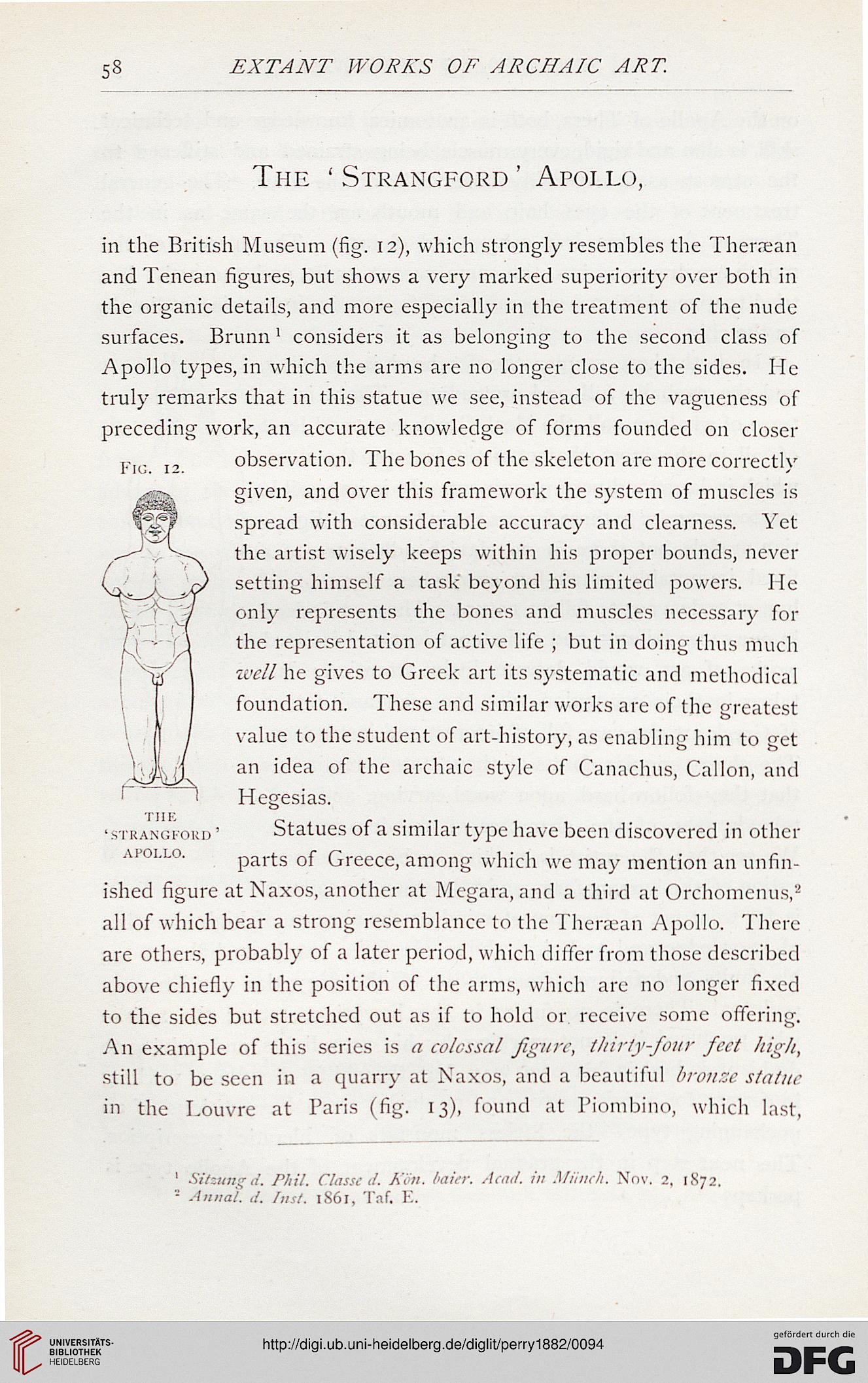58
EXTANT WORKS OF ARCHAIC ART.
The ' Strangford ' Apollo,
in the British Museum (fig. 12), which strongly resembles the Theraean
and Tenean figures, but shows a very marked superiority over both in
the organic details, and more especially in the treatment of the nude
surfaces. Brunn 1 considers it as belonging to the second class of
Apollo types, in which the arms are no longer close to the sides. He
truly remarks that in this statue we sec, instead of the vagueness of
preceding work, an accurate knowledge of forms founded on closer
observation. The bones of the skeleton are more correctly
given, and over this framework the system of muscles is
spread with considerable accuracy and clearness. Yet
the artist wisely keeps within his proper bounds, never
setting himself a task beyond his limited powers. He
only represents the bones and muscles necessary for
the representation of active life ; but in doing thus much
well he gives to Greek art its systematic and methodical
foundation. These and similar works are of the greatest
value to the student of art-history, as enabling him to get
an idea of the archaic style of Canachus, Callon, and
THE
' STRANGFORD
A HOLLO.
Hcgesias.
Statues of a similar type have been discovered in other
parts of Greece, among which we may mention an unfin-
ished figure at Naxos, another at Megara, and a third at Orchomenus,2
all of which bear a strong resemblance to the Theraan Apollo. There
are others, probably of a later period, which differ from those described
above chiefly in the position of the arms, which are no longer fixed
to the sides but stretched out as if to hold or receive some offering.
An example of this series is a co/cssal figure, thirty-four feet high,
still to be seen in a quarry at Naxos, and a beautiful bronze Statue
in the Louvre at Paris (fig. 13), found at Piombino, which last,
1 Sitttmgd, Phil. Clotted. Kim. baier. Acad, in Aftittch. Nov. 2. 1872.
- Annul, d. Inst. 1S61, Tat E.
EXTANT WORKS OF ARCHAIC ART.
The ' Strangford ' Apollo,
in the British Museum (fig. 12), which strongly resembles the Theraean
and Tenean figures, but shows a very marked superiority over both in
the organic details, and more especially in the treatment of the nude
surfaces. Brunn 1 considers it as belonging to the second class of
Apollo types, in which the arms are no longer close to the sides. He
truly remarks that in this statue we sec, instead of the vagueness of
preceding work, an accurate knowledge of forms founded on closer
observation. The bones of the skeleton are more correctly
given, and over this framework the system of muscles is
spread with considerable accuracy and clearness. Yet
the artist wisely keeps within his proper bounds, never
setting himself a task beyond his limited powers. He
only represents the bones and muscles necessary for
the representation of active life ; but in doing thus much
well he gives to Greek art its systematic and methodical
foundation. These and similar works are of the greatest
value to the student of art-history, as enabling him to get
an idea of the archaic style of Canachus, Callon, and
THE
' STRANGFORD
A HOLLO.
Hcgesias.
Statues of a similar type have been discovered in other
parts of Greece, among which we may mention an unfin-
ished figure at Naxos, another at Megara, and a third at Orchomenus,2
all of which bear a strong resemblance to the Theraan Apollo. There
are others, probably of a later period, which differ from those described
above chiefly in the position of the arms, which are no longer fixed
to the sides but stretched out as if to hold or receive some offering.
An example of this series is a co/cssal figure, thirty-four feet high,
still to be seen in a quarry at Naxos, and a beautiful bronze Statue
in the Louvre at Paris (fig. 13), found at Piombino, which last,
1 Sitttmgd, Phil. Clotted. Kim. baier. Acad, in Aftittch. Nov. 2. 1872.
- Annul, d. Inst. 1S61, Tat E.




